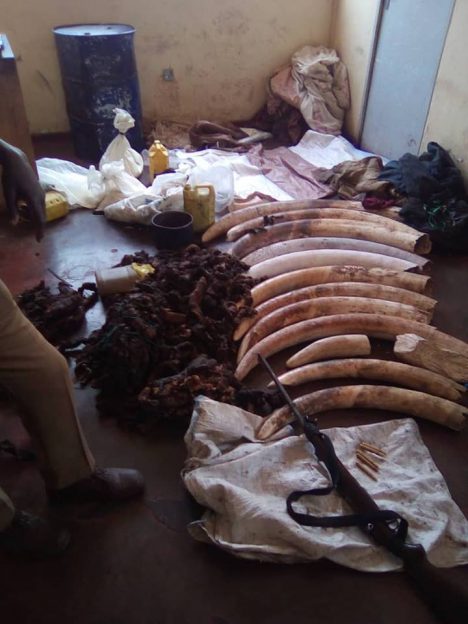Trophy hunting of bulls affecting African elephant behavior, breeding patterns and social cohesion
Selective trophy hunting of young bull elephants is affecting the
population structure, behavior and future breeding patterns among
African elephants in the Malipati Safari Area (MSA) of south-eastern
Zimbabwe, new research has revealed.

Ivory, a hunting rifle, dried elephant meat and personal items recovered from suspected Zambian elephant poachers in Zimbabwe
The MSA is part of the Gonarezhou National Park complex, a vast
wildlife habitat which forms the Zimbabwean component of the Greater
Limpopo Transfrontier Park, a giant Southern African trans-frontier
conservation area that includes Mozambique and South Africa.
The report entitled: “Trophy Hunting and Possible Source-Sink Dynamics
in Protected Areas: Insights from Trophy Size and Offtake Patterns in
Southeast Zimbabwe”, was written by Augustine Jeke, Admire
Chanyandura, Victor K. Mposhi, Daphine Madhlamoto and Edson Gandiwa of
the Chinhoyi University School of Wildlife, Ecology and Conservation.
The study assessed trophy size, quota utilization and distribution of
trophy hunting kill sites of African elephant, Cape buffalo, greater
kudu and leopard in the period between 2007 and 2014 in Malipati.
Using the Safari Club International (CSI) standard, the researchers
recorded a significant decline in Cape buffalo trophy sizes. Greater
kudu trophy sizes were found to be constant but higher that the SCI
score.
Leopard trophy sizes were found to be higher than the SCI score and
increased with time. Information gathered on the distribution of kill
sites indicated widespread violations of the Zimbabwe Parks and
Wildlife Management (Zimparks) Act, which prohibits trophy hunting in
protected areas.
“Quota utilization for African elephant and Cape buffalo increased
while that of greater kudu and leopard did not change between 2007 and
2014. Some kill sites, in particular, for the African elephant and
Cape buffalo, were within the buffer area with the state protected
area, i.e. the Gonarezhou National Park,” the report said.
The researchers said the significant increases in trophy sizes for the
MSA’s African elephant population confirmed the notions that the
broader Gonarezhou area remains home to some of Africa’s large tusker
populations, making it a favorite destination for international trophy
hunters.
“This presupposes the existence of ‘source and sink’ dynamics in
trophy individuals, where Malipati Safari Area acts as a sink, with
the GNP being the source of big tuskers over time. However, our
findings were contrary to those found in Matetsi Safari Area
(Zimbabwe), Sengwa Wildlife Research Area, (Zimbabwe) and Selous Game
Reserve (Tanzania), where declining African elephant trophy sizes were
reported.
“Nonetheless, African elephant trophy sizes were below the minimum SCI
score of 90 pounds. Trophy sizes below minimum SCI score suggest the
harvesting of young bulls, which has negative impacts on population
structure and future breeding patterns. Over time, there is loss of
trophy hunting induced behavioral adaptation by older African elephant
bulls, such as avoidance of risky hunting areas, which tends to affect
social cohesion and survival of breeding herds,” the report stated.
Further, the decline trend in Cape buffalo trophy size recorded in
Malipati was replicated in the Sengwa Wildlife Research Area in
north-west Zimbabwe, the Selous Game Reserve in Tanzania and parts of
the Kruger National Park complex in South Africa.
“The declines in Cape buffalo trophy size could be attributed to the
harvesting regime and trophy hunting pressure. In the MSA, trophy
hunting pressure has been reported to have reduced densities of common
large herbivores, as have the impacts of the illegal bush-meat trade
where Cape buffalo is one of the key target species in in this area.”
The SCI trophy scoring system was found to have negative impacts on
Cape buffalo populations because its highest scoring trophies come
from soft-bossed males (green bulls), which encourages hunters to
target bulls in the prime reproductive stage and may have disruptive
effects on the gene-pool.
Although leopard trophy sizes were found to be above the minimum SCI
score of 14 inches and increasing in the period between 2007 and 2014,
increased hunting pressure compromised trophy sizes of hunted
carnivore species like leopard in parts of the KwaZulu Natal region of
South Africa and the Selous Game Reserve in Tanzania.
In the period under review, the Malipati Safari Area recorded a
significant increase in the utilization of African elephant and Cape
buffalo quotas, a trend attributed to attractiveness and demand for
the two species among international trophy hunters.
To minimise the possible ‘phenotypic plasticity’ loss through the loss
of desirable traits (eg.big horns or tusks), the MSA should promote
sustainable harvesting strategies to save the preferred species.
The wide distribution of African elephant and buffalo kill sites
within the 400m buffer zone, which separates the MSA hunting area from
the protected zones in Gonarezhou National Park, was attributed to
free-roaming elephant behaviour and their stay within proximity to
water sources along the Mwenezi River.
However, most of the kill sites are possibly proof of widespread
illegal hunting: “Nonetheless, the presence of animal kill sites in
restricted zones violates provisions of the Statutory Instrument 362
of the 1990 of the Parks and Wildlife Act of Zimbabwe on restrictions
and prohibitions on hunting areas.
“There is need to promote responsible and ethical hunting practices to
ensure that trophy hunting is sustainable and continues to contribute
towards conservation. The possible existence of source and sink
dynamics between GNP and MSA, respectively, within the Greater Limpopo
Transfrontier Park (GLTP) requires a more careful approach to ensure
that robust scientific and monitoring programs are promoted to enhance
the sustainability of trophy hunting as a conservation tool,” the
report said.
The report concluded that the MSA experienced variable trophy hunting
impacts as evidenced by the harvesting of trophies below minimum SCI
scores (e.g., African elephant and Cape buffalo).
Among other mitigatory measures, the MSA should adopt more
scientifically robust, adaptable and participatory quota setting
process, enhance adherence to good practices of ethical hunting and
develop robust hunt monitoring systems to prevent illegal hunting.
ALSO OF INTEREST…
Mozambique elephant poaching 2018
Suspected Zambian poachers abandon 172 kilograms of elephant tusks in Zimbabwe
Trophy hunting of bulls affecting African elephant behavior, breeding patterns and social cohesion
South Africa allocates seven leopards to 2018 trophy hunting quota














